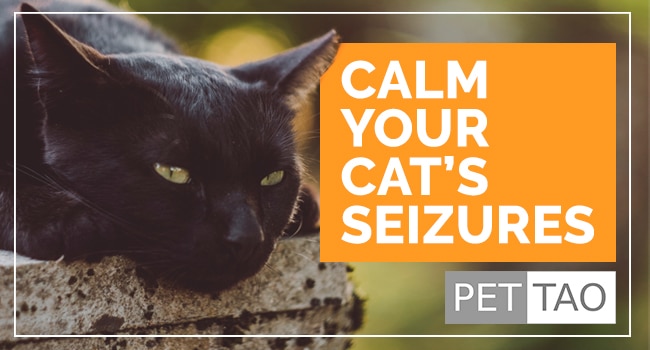Watching your beloved cat suffer from seizures is a very disturbing experience!
Unfortunately, cat seizures are quite common and have many different causes.
Causes of Feline Seizures
A simple explanation of a feline seizure is a sudden, abnormal, and disorganized discharge of electrical signals from a cat’s brain cells.
Cats have seizures for many different reasons.
Sometimes, seizures are unexplained. You never know the cause.
Sometimes a cat will have a seizure, then not have another for the rest of his/her life.
Other cats suffer from weekly seizures.
Toxins are the single most common cause of seizures in cats.
Other common causes of cat seizures are:
- Epilepsy
- Trauma
- Illness
- Brain tumors
- Genetic abnormalities
- Viruses
- Certain sounds
What Happens During Feline Seizures?
If your cat starts having a seizure, the first thing that usually happens is your cat collapsing to the ground.
Then, your cat goes stiff and starts having convulsions.
Convulsions are uncontrolled muscle contractions.
Convulsions might make it look like your cat is paddling her feet, jerking her body, snapping her jaws, or other similar movements.
Depending on the severity of the episode, your cat may defecate, urinate, and whine or cry.
Seizures look painful, but in reality, cats are unconscious during the episodes and don’t feel anything.
Fortunately, cats do not suffer during the episodes.
After the episode, cats are often disoriented and confused.
A post-seizure cat might wander aimlessly or just find a quiet place to hide.
Sometimes cats suffer temporary blindness after an episode.
Some cats are extra hungry or thirsty.
Often, cats recover immediately after a seizure, though some cats may seem a bit “off” for up to 24 hours.
Many cats experience seizures while resting or asleep, often during the night or very early in the morning.
Symptoms of Feline Seizures
Some pet parents notice warning signs before their cat has a seizure.
Warning signs include:
- Behavior – acting dazed, frightened, worried or stressed
- Visual disturbances
- Hiding
- Seeking extra attention
- Muscle contractions
- Trouble controlling urination or bowels
How Di Tan Tang Helps Control Seizures in Cats
Some vets recommend pharmaceuticals to help control seizures in cats.
Often, though, pet parents and holistic veterinarians prefer trying something natural first.
Herbs provide a natural and gentle alternative for many cats.
Most herbs don’t have side effects.
Di Tan Tang: Western Philosophy
Di Tan Tang helps cats suffering from:
- Convulsions
- Epilepsy
- Seizures
Di Tan Tang: Eastern Philosophy
Eastern medicine treats a disease’s root cause(s) rather than symptoms.
Accordingly, TCVM veterinarians evaluate feline seizures differently than Western veterinarians.
TCVM vets look for signs of imbalance.
Di Tan Tang helps cats with the following TCVM signs:
- Coughs producing yellow phlegm
- Fever
- Wind-Phlegm with Heat causing Internal Wind
- Becoming unconscious
- Constipation
- A greasy coated, red or purple tongue
- Foaming at the mouth while screaming
- Slippery pulse
- Sudden seizures
- Wood personality (irritable or agitated)
How Di Tan Tang Works
Di Tan Tang is a TCVM blend of 13 different Eastern herbs.
The herbs perform synergistically, balancing systems and meridians in the body.
Di Tan Tang addresses the underlying causes of seizures in cats.
The underlying cause of a disease is always an imbalance somewhere in the body.
Di Tang Tang addresses your cat’s imbalances while treating the symptoms of feline seizures.
According to Traditional Chinese Medicine, Di Tan Tang works by:
- Transforming phlegm
- Clearing internal wind
- Stopping seizures
What Are the Ingredients in Di Tan Tang?
The main ingredients in Di Tan Tang are:
- Chen Pi moves Qi and transforms phlegm
- Dan Nan Xing transforms phlegm
- Fu Ling drains damp
- Gan Cao harmonizes
- Gan Jiang harmonizes
- Gou Teng extinguishes internal wind and clears liver heat
- Hai Zao transforms phlegm, clears heat, and softens the hardness
- Kun Bu transforms phlegm, softens the hardness, and drains water
- Ren Shen (Kirin) tonifies Qi
- Si Jue Ming clears liver heat
- Shi Chang Pu opens the orifice and eliminates Damp
- Zhi Shi moves Qi
- Shu Ru transforms phlegm
Dr. Huisheng Xie, the founder of the Chi Institute in Reddick, FL, created Di Tan Tang specifically for animals.
Dr. Xie based Di Tan Tang on the ancient TCM formula from Ji Sheng Fang by Yan Yon-He, 1923.
Di Tan Tang works best when combined with plenty of water, Eastern Food Therapy, and moderate exercise.
Note: Information on this site is for educational purposes only and is not meant to substitute the advice provided by your own veterinarian.
Get Di Tan Tang at TCVM Pet Supply








